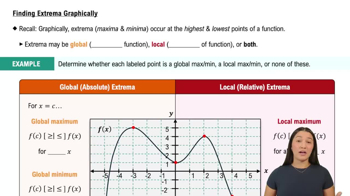Table of contents
- 0. Functions7h 52m
- Introduction to Functions16m
- Piecewise Functions10m
- Properties of Functions9m
- Common Functions1h 8m
- Transformations5m
- Combining Functions27m
- Exponent rules32m
- Exponential Functions28m
- Logarithmic Functions24m
- Properties of Logarithms34m
- Exponential & Logarithmic Equations35m
- Introduction to Trigonometric Functions38m
- Graphs of Trigonometric Functions44m
- Trigonometric Identities47m
- Inverse Trigonometric Functions48m
- 1. Limits and Continuity2h 2m
- 2. Intro to Derivatives1h 33m
- 3. Techniques of Differentiation3h 18m
- 4. Applications of Derivatives2h 38m
- 5. Graphical Applications of Derivatives6h 2m
- 6. Derivatives of Inverse, Exponential, & Logarithmic Functions2h 37m
- 7. Antiderivatives & Indefinite Integrals1h 26m
- 8. Definite Integrals4h 44m
- 9. Graphical Applications of Integrals2h 27m
- 10. Physics Applications of Integrals 2h 22m
5. Graphical Applications of Derivatives
Intro to Extrema
Problem 4.R.5a
Textbook Question
Use the graphs of ƒ' and ƒ" to complete the following steps. <IMAGE>
a. Find the critical points of f and determine where f is increasing and where it is decreasing.
 Verified step by step guidance
Verified step by step guidance1
Identify the critical points of the function f by finding where the derivative f' is equal to zero or undefined. These are the x-values where the graph of f' crosses the x-axis or has discontinuities.
Determine the intervals where the function f is increasing by analyzing the sign of f'. If f' is positive on an interval, then f is increasing on that interval.
Determine the intervals where the function f is decreasing by analyzing the sign of f'. If f' is negative on an interval, then f is decreasing on that interval.
Use the second derivative f" to confirm the nature of the critical points. If f" is positive at a critical point, it indicates a local minimum, and if f" is negative, it indicates a local maximum.
Summarize the findings by listing the critical points and specifying the intervals of increase and decrease for the function f, based on the analysis of f' and f".
 Verified video answer for a similar problem:
Verified video answer for a similar problem:This video solution was recommended by our tutors as helpful for the problem above
Video duration:
4mPlay a video:
Was this helpful?
Key Concepts
Here are the essential concepts you must grasp in order to answer the question correctly.
Critical Points
Critical points of a function occur where its derivative is zero or undefined. These points are essential for identifying local maxima and minima, as they indicate where the function's slope changes. To find critical points, one typically sets the first derivative, f', equal to zero and solves for the variable.
Recommended video:

Critical Points
Increasing and Decreasing Intervals
A function is increasing on an interval where its derivative, f', is positive, and decreasing where f' is negative. By analyzing the sign of the derivative around the critical points, one can determine the intervals of increase and decrease. This information is crucial for understanding the overall behavior of the function.
Recommended video:

Determining Where a Function is Increasing & Decreasing
Second Derivative Test
The second derivative test involves using the second derivative, f'', to determine the concavity of the function at critical points. If f'' is positive at a critical point, the function is concave up, indicating a local minimum; if f'' is negative, the function is concave down, indicating a local maximum. This test helps confirm the nature of critical points found using the first derivative.
Recommended video:

The Second Derivative Test: Finding Local Extrema

 5:58m
5:58mWatch next
Master Finding Extrema Graphically with a bite sized video explanation from Callie
Start learning





